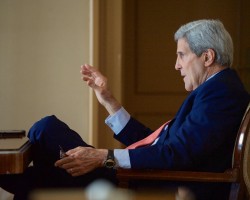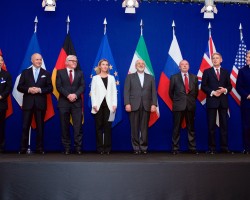
Five Myths About the Iran Framework Deal
Five Myths about the Iran Framework Deal
April 6, 2015
The framework for a comprehensive agreement reached by P5+1 negotiators at Lausanne, Switzerland, last week has established the overarching terms of a sustainable, peaceful solution to the Iranian nuclear issue. The terms are more favorable than many expected, and even skeptics of diplomacy – from experts like United Against Nuclear Iran’s Gary Samore to pundits like Bill O’Reilly – say it’s a credible deal worth pursuing. However, some people still aren’t convinced and have brought out many of the same arguments against the deal that were being made before there was a deal to criticize. Here are five of the top reasons critics say the United States should reject the deal, and why they’re wrong.
Myth: There’s a better deal to be had if the United States just applies more sanctions and waits out Iran. That’s what we’ve done, and it worked: It brought us to this deal. That’s not only how pro-diplomacy advocates see the deal, it’s also how the rest of the international community sees it. Trying to renegotiate for better terms runs the risk of alienating the nations that have made the sanctions regime effective in the first place. “Enacting new, tough sanctions in an effort to force Iran toward a ‘better’ deal would mystify and alarm the rest of the world, isolating and weakening us,” writes NSN Advisory Board Chair Sandy Berger. If the United States rejects this agreement, other countries may begin to reevaluate their decision to participate in international sanctions, and “countries like India and South Korea, who don’t feel threatened by an Iran nuclear weapon, will be only too happy to find a pretext to break out of the sanctions.” The nuclear sanctions served their purpose: They brought Iran to the table and compelled concessions. “There is no second bite at this apple,” writes Berger. “This is a good deal. We should not be distracted by talk of a better one.” [Sandy Berger via Politico, 4/5/15]
Myth: The deal leaves Iran “a free path to the bomb.” That’s what Israeli Prime Minister Benjamin Netanyahu said this weekend, and has consistently said for months, long before there was any deal to actually criticize. And now that the framework has been released, it’s demonstrably false. “This is a good deal because it satisfies our need to block all four pathways to a nuclear weapon,” Secretary of Energy Ernest Moniz told NPR on Friday, who explained that Iran would not be able to pursue either of its uranium tracks to build a bomb, its potential plutonium track, or a covert enrichment track. He noted that the agreement would extend Iran’s breakout time from two months to a year. “The Lausanne approach would effectively take the option of racing to the bomb at the known, inspected facilities off the table for Iran, with a combination of limits and inspections that offer high confidence that any such effort would be noticed in plenty of time for the world to act,” Harvard Professor Matthew Bunn wrote yesterday. The deal also has provisions that would “increase the chance that any secret sites would be found in time,” such as giving inspectors access “to go and check any site where well-documented suspicions arose” and an enforceable monitoring regime “so that any illicit procurement would be a violation of the pact.” [Ernest Moniz via NPR, 4/3/15. Matthew Bunn via the National Interest, 4/5/15]
Myth: The deal will lead to an arms race as other countries like Saudi Arabia and Turkey rush for bombs of their own. A regional nuclear cascade is actually more likely without a deal than with one. “The alternative is no comprehensive P5+1 and Iran nuclear deal, which would result in a less constrained — if not unconstrained — Iranian nuclear program with less monitoring. This poses more of a threat to regional security and would be more likely to increase the possibility of a cascade of regional fuel making,” writes Kingston Reif, Director for Disarmament and Threat Reduction at the Arms Control Association. And as Colin Kahl, Melissa Dalton, and Matthew Irvine noted in a 2013 CNAS report, there are “significant disincentives – including the prospect of worsening Saudi Arabia’s security environment, rupturing strategic ties with the United States, damaging the country’s international reputation and making the Kingdom the target of sanctions” that could dissuade Riyadh from this course. So far, Saudi Arabia has met the P5+1 proposal with cautious optimism; in a statement today, the Saudi cabinet “expressed hope for attaining a binding and definitive agreement that would lead to the strengthening of security and stability in the region and the world.” [Kingston Reif via the National Interest, 3/2/15. Colin Kahl et al, 2/19/13. Saudi Council of Ministers via Reuters, 4/6/15]
Myth: The deal doesn’t do enough to address the potential military dimensions (PMD) of Iran’s nuclear program. The P5+1 negotiations are about the future of Iran’s nuclear program, not its past – the investigation of PMD is on a separate track being handled by the International Atomic Energy Agency. That it is even mentioned in the proposed parameters of an agreement – the White House states “Iran will implement an agreed set of measures to address the IAEA’s concerns regarding the Possible Military Dimensions (PMD) of its program” – is somewhat surprising and promising. But as Jeffrey Lewis has noted, the United States does not need the IAEA to complete its investigation to reach a good deal, and waiting on the IAEA could delay an agreement and miss the international community’s window of opportunity. As Kelsey Davenport, Director for Nonproliferation Policy at the Arms Control Association, has written, “Resolving the PMD issue is important but is not a prerequisite for a comprehensive nuclear agreement. Nor is it realistic or necessary to expect a full ‘confession’ from Iran that it pursued nuclear weapons in the past.” As Jeffrey Lewis has noted, the U.S. intelligence community believes Iran halted its nuclear weapons research sometime around 2003. “When a politician, analyst, or pundit mentions an Iranian ‘nuclear weapons program’ they are referring to a program that the [intelligence community] is not aware of,” writes Micah Zenko of the Council on Foreign Relations. The deal prevents Iran from obtaining a weapon in the future – more knowledge of Iran’s past misdeeds aren’t necessary to do that. [White House, 4/2/15. Kelsey Davenport, 10/17/14]
Myth: The deal needs to address Iran’s other bad behavior in the region, including funding for terrorism and human rights abuses. Like PMD, Iran’s other misdeeds are outside the scope of the negotiations. The United States has an opportunity to sustainably and conclusively resolve an issue that has threatened the regional security of the Middle East for decades – that shouldn’t be ignored because of other concerns. “The Iran nuclear agreement is important not despite other troubles in the region but because of them,” writes Berger. “Each challenge would be more difficult and dangerous if Iran’s nuclear program was unconstrained and unmonitored, let alone if Iran were to develop a nuclear weapon and spark others in the region to follow. Under the agreement that is emerging, we will have a high degree of confidence — as will others in the region — that Iran’s nuclear program is seriously constrained. Walling off the nuclear threat does not extinguish the fires that are burning in the region. But it does remove what would be the most combustible fuel.” [Sandy Berger via Politico, 4/5/15]





